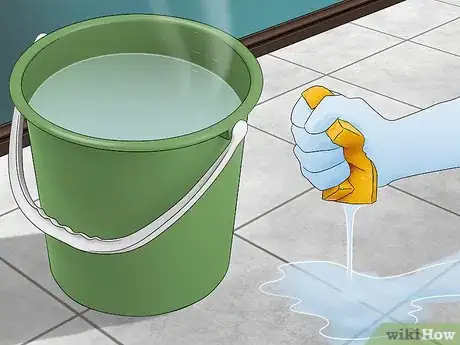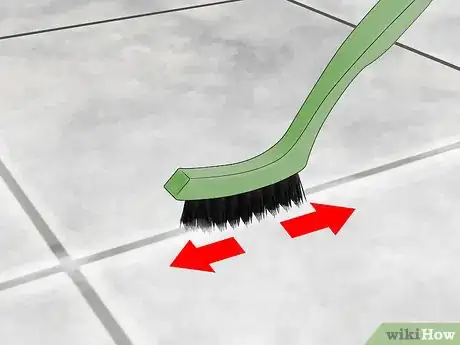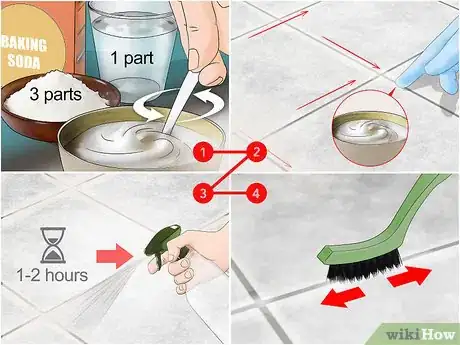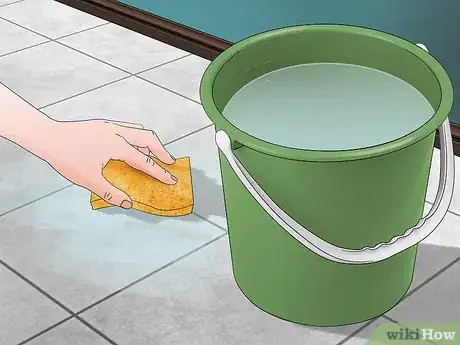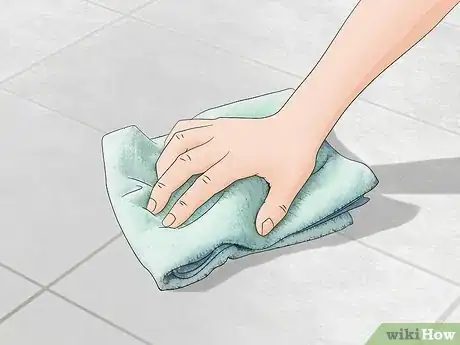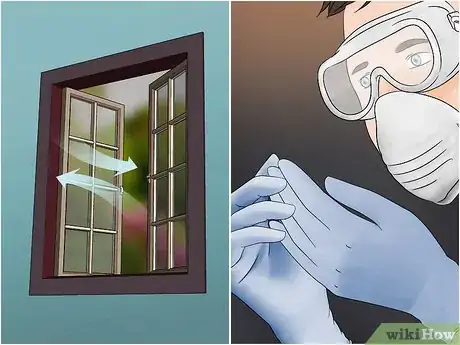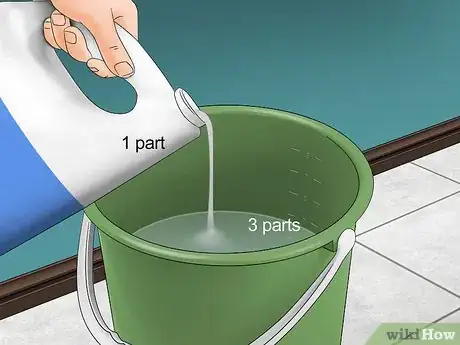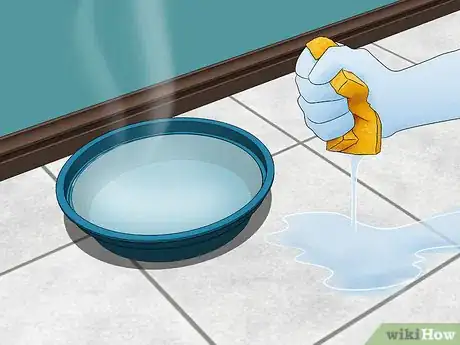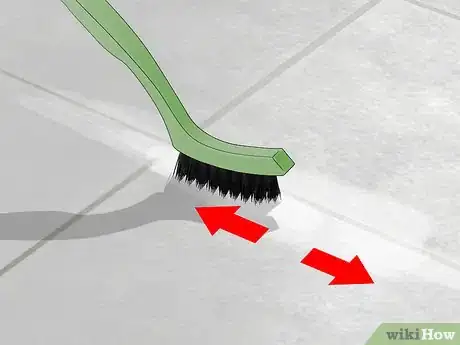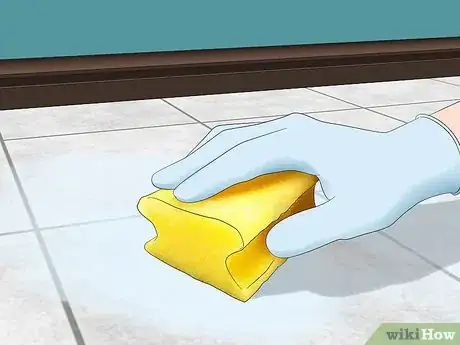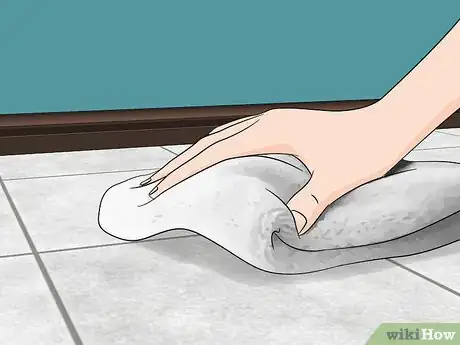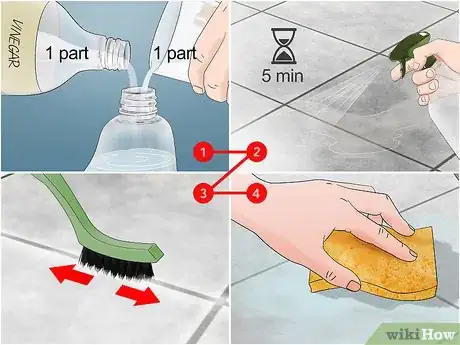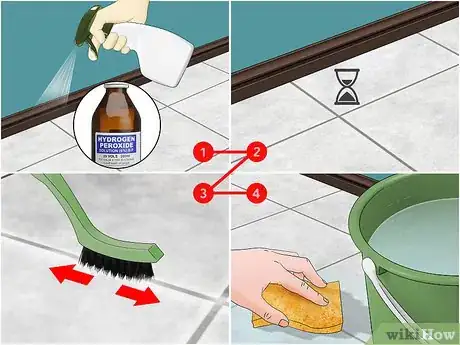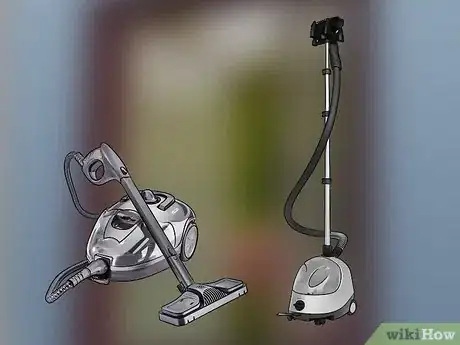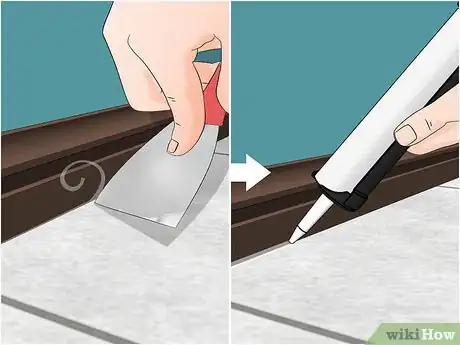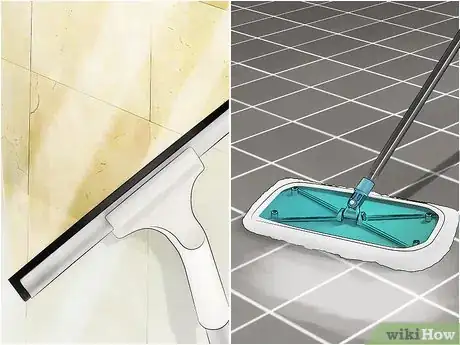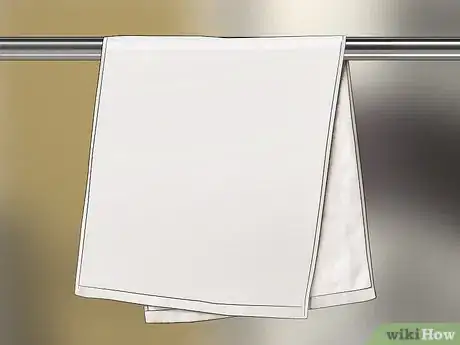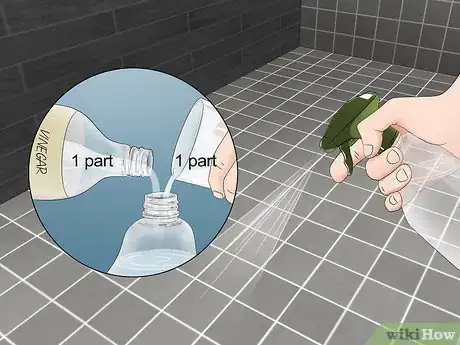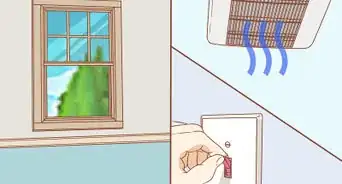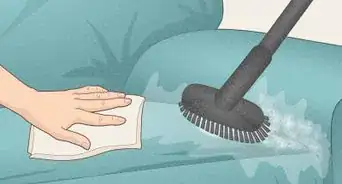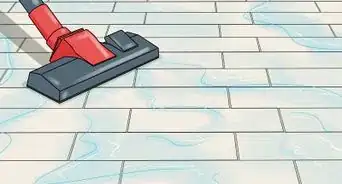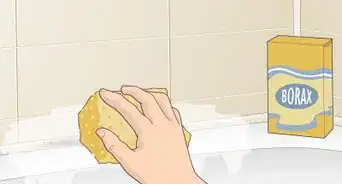This article was co-authored by Chris Willatt. Chris Willatt is the owner and founder of Alpine Maids, a cleaning agency in Denver, Colorado started in 2015. Alpine Maids has received Angie's List Super Service Award for three years in a row since 2016 and has been awarded Colorado's "Top Rated Local House Cleaning" Award in 2018.
There are 7 references cited in this article, which can be found at the bottom of the page.
This article has been viewed 99,463 times.
Cleaning moldy grout requires scrubbing. If the grout is on your flooring, vacuum or sweep before wet cleaning the floor. Unglazed tile should only be cleaned with warm water, so don’t use any other cleaning agents on its grout. A diluted bleach solution is the most effective way to remove mold from grout, but its hazardous nature requires safety precautions. Since prevention is the best option for keeping mold away, make sure to maintain your mold-free grout once you’ve cleaned it.
Things You Should Know
- Scrub the grout vigorously with a brush and warm water or baking soda paste before rinsing and drying the grout.
- Try out alternative methods or scrubbing with a diluted bleach solution (just make sure you take the proper safety and ventilation precautions!)
- To keep grout mold-free, cut down on moisture in your home, wipe tiles after you shower or cook, keep nearby fabrics dry, and clean the area regularly.
Steps
Scrubbing with Water
-
1Apply warm water. Fill a bucket or spray bottle with warm water. Douse small sections of grout at a time.[1]
-
2Scrub the grout in a vigorous, back-and-forth motion. Use a narrow scrub brush, tile brush, or stiff toothbrush.[2] If you’re having trouble getting into corners or grout lines with your brush, try using a Mr. Clean Magic Eraser for those areas.[3]
- Instead of a scrub brush, you can try a closed-loop microfiber cloth. If so, wear gloves to protect your hands from the friction.
Advertisement -
3Try a baking soda paste. If water alone doesn’t work, mix three parts baking soda with one part water to form a paste.[4] Apply the paste to the grout, and let it sit for one to two hours. Spray with plain water, then scrub the grout again.[5]
- Alternately, make a paste from two parts baking soda to one part hydrogen peroxide. Let the paste sit on the grout for several minutes before scrubbing it and rinsing it clean.
-
4Rinse the grout with water. Use clean running water, a spray bottle or a clean, wet sponge to rinse the grout.
-
5Dry the grout. Use clean cloths to buff remaining moisture from the grout. Open a window or turn on a fan until the grout is dry to the touch.[6]
Using Diluted Bleach
-
1Ensure proper safety and ventilation. Open the window and/or run a fan. Wear non-porous gloves, a mask, and safety glasses.
- Chlorine bleach is an eye and skin irritant. The fumes can affect the respiratory tract. Adequate protection and ventilation are essential.[7]
-
2Make a diluted bleach solution. Mix three parts water to one part chlorine bleach. Alternately, you can purchase a cleaning solution that contains some bleach.[8]
- If your grout is colored, using bleach may cause it to fade, especially if used regularly.
- You can repeat this method with a slightly higher concentration of bleach (for example, half bleach, half water) if the 3-to-1 ratio doesn’t work.
- Never attempt to mix other chemicals with diluted bleach. For example, ammonia – found in many cleaning agents – emits toxic fumes when mixed with bleach.
-
3Wet tiles with water. Thoroughly wet any tiles in the area with warm water before using any bleach solution. Even if you’re just cleaning the grout, spatter will land on tiling. Pre-wetting tiles with water saturates them to limit their absorption of chemicals.[9]
-
4Apply the bleach solution. Use a narrow brush such as an old, stiff toothbrush or any natural bristle or nylon brush. Scrub the grout with the solution in small sections.[10]
- Bleach can lighten mold so that it isn’t visible. Scrubbing is needed to reach into grout’s pores and remove organic growth.[11]
-
5Soak and rinse the grout. Let the solution remain on each section of grout for about three minutes. Then rinse it clean with clear water.[12]
- Letting bleach sit for more than a few minutes can cause staining, streaking, or even breakage to tile.
-
6Dry the grout. Buff away any remaining moisture with clean cloths. Leave the window open or fan running until the grout feels totally dry.
Trying Alternative Methods
-
1Spray the grout with diluted vinegar. Fill a bucket or spray bottle with one part water to one part white vinegar. Leave the solution on the grout for five minutes. Scrub the grout with a narrow scrub brush or stiff toothbrush. Rinse the area clean with warm water.[13]
- Vinegar is acid-based, so make sure to do a small test area first to make sure the solution doesn’t affect your surrounding tile.
- Optionally, apply a paste of baking soda and water to the grout before dousing it with the vinegar solution. The combination will bubble up. Then scrub and rinse.[14]
-
2Treat the grout with hydrogen peroxide. Make sure to do a small test area first. Use a spray bottle or sponge to apply hydrogen peroxide to your grout. Allow it to sit for several minutes. Scrub the grout with a narrow scrub brush or toothbrush. Rinse completely with warm water.[15]
- Try repeating this several times.
- Baking soda is abrasive, so keep it off the tile as much as possible.
-
3Use a steam cleaner. Choose a machine with high heat and a brush attachment.[16] Don’t use a machine with a beater bar, which can damage tile. You may want to check if your brand of tile is compatible with using a steam cleaner first.[17]
- For example, steam cleaners are not recommended for ceramic tile.[18]
-
4Strip and reseal the caulk. If all else fails, use a sharp-edged tool to scrape away the caulk. Clean the area with a solution of three parts water to one part bleach, and let it dry. Use mildew-resistant caulk to discourage future mold. Make sure to seal the grout correctly so that organic growth won’t re-enter.[19]
- If you think the mold may have gotten underneath tiling or otherwise penetrated the structure of the room, you may want to renovate and re-tile the area.
Maintaining Mold-Free Grout
-
1Cut down on moisture. Keep a door or window open when you’re showering. Alternately, run a dehumidifier or portable fan after showering. If you have a vent fan, run it before, during, and after your shower.[20]
- For example, turn on your vent fan before a morning shower, and keep it running until you leave for the day. Even when the mirror is no longer foggy, there can still be moisture in the air.
- Mold and mildew thrive where it’s warm, airless and damp.
-
2Wipe tiles and grout after showering or cooking. Dry wet grout thoroughly after using moisture in the kitchen or bathroom. Keep a squeegee in the bathroom and squeegee the walls and floor after showering.[21]
- Using a squeegee after showering will cut down on surface buildup.
-
3Spray diluted tea tree oil regularly as a mold preventative. Add ten drops of tea tree oil to a clean spray bottle filled with water. Keep the spray bottle in the bathroom and use the “mist” setting to spray tiles and grout after showering.[22]
- You should perform this on a small test area first to make sure there is no negative effect.
-
4Keep nearby fabrics dry. Spread out any wet or damp towels so they can totally dry. For rooms that face a lot of moisture, such as kitchens and bathrooms, opt for synthetic materials, since they hold less moisture.[23]
- For example, choose polyester or vinyl for items like bathmats and curtains.
-
5Clean routinely to prevent mold. Spray the grout monthly with an anti-fungal solution. For example, fill a spray bottle with one part water to one part white vinegar. Spray and wipe down the grout. Let the solution dry naturally rather than rinsing it off.
- If your grout is in a bathroom, clean soap scum weekly.
Expert Q&A
-
QuestionWhat is the best grout cleaner for mold and mildew?
 Chris WillattChris Willatt is the owner and founder of Alpine Maids, a cleaning agency in Denver, Colorado started in 2015. Alpine Maids has received Angie's List Super Service Award for three years in a row since 2016 and has been awarded Colorado's "Top Rated Local House Cleaning" Award in 2018.
Chris WillattChris Willatt is the owner and founder of Alpine Maids, a cleaning agency in Denver, Colorado started in 2015. Alpine Maids has received Angie's List Super Service Award for three years in a row since 2016 and has been awarded Colorado's "Top Rated Local House Cleaning" Award in 2018.
House Cleaning Professional A bleach pen will take care of the mold. First clean the grout with a scrub brush or a tooth brush with good bristles, using a good cleaning product again, or just soap and water, or even baking soda. Make sure to scrub it well, as it is porous, then rinse it out, and then use a bleach pen. Just kind of draw a line through it. Make sure to provide a good ventilation and limit your exposure to bleach.
A bleach pen will take care of the mold. First clean the grout with a scrub brush or a tooth brush with good bristles, using a good cleaning product again, or just soap and water, or even baking soda. Make sure to scrub it well, as it is porous, then rinse it out, and then use a bleach pen. Just kind of draw a line through it. Make sure to provide a good ventilation and limit your exposure to bleach.
Warnings
- Follow all safety instructions on the label of any cleaning agents you use.⧼thumbs_response⧽
- Don’t allow bleach to come in contact with your eyes or skin.⧼thumbs_response⧽
Things You'll Need
- Warm water
- Bucket
- Narrow brush
- Mr. Clean Magic Eraser (or similar product)
- Baking soda
- Non-porous gloves
- Mask
- Safety glasses
- Fan or open window
- Spray bottle
- Chlorine bleach
- Small stiff brush
- Clean cloths
References
- ↑ http://cleanmyspace.com/how-to-get-rid-of-bathroom-mold/
- ↑ http://cleanmyspace.com/how-to-get-rid-of-bathroom-mold/
- ↑ http://www.womansday.com/home/organizing-cleaning/tips/a1597/get-rid-of-mildew-for-good-107485/
- ↑ Chris Willatt. House Cleaning Professional. Expert Interview. 1 July 2019.
- ↑ http://cleanmyspace.com/how-to-get-rid-of-bathroom-mold/
- ↑ http://cleanmyspace.com/how-to-get-rid-of-bathroom-mold/
- ↑ http://www.naturallivingideas.com/clean-tiles-grout/
- ↑ http://www.womansday.com/home/organizing-cleaning/tips/a1597/get-rid-of-mildew-for-good-107485/
- ↑ https://www.nps.gov/tps/how-to-preserve/briefs/40-ceramic-tile-floors.htm#preserve
- ↑ https://www.nps.gov/tps/how-to-preserve/briefs/40-ceramic-tile-floors.htm#preserve
- ↑ http://www.naturallivingideas.com/clean-tiles-grout/
- ↑ https://www.nps.gov/tps/how-to-preserve/briefs/40-ceramic-tile-floors.htm#preserve
- ↑ Chris Willatt. House Cleaning Professional. Expert Interview. 1 July 2019.
- ↑ Chris Willatt. House Cleaning Professional. Expert Interview. 1 July 2019.
- ↑ https://www.apartmenttherapy.com/how-to-clean-grout-138432
- ↑ http://www.womansday.com/home/organizing-cleaning/tips/a1597/get-rid-of-mildew-for-good-107485/
- ↑ http://www.creativehomemaking.com/cleaning/tile-floors.shtml
- ↑ https://www.nps.gov/tps/how-to-preserve/briefs/40-ceramic-tile-floors.htm#preserve
- ↑ http://www.womansday.com/home/organizing-cleaning/tips/a1597/get-rid-of-mildew-for-good-107485/
- ↑ http://www.womansday.com/home/organizing-cleaning/tips/a1597/get-rid-of-mildew-for-good-107485/
- ↑ http://www.womansday.com/home/organizing-cleaning/tips/a1597/get-rid-of-mildew-for-good-107485/
- ↑ http://cleanmyspace.com/how-to-get-rid-of-bathroom-mold/
- ↑ http://www.womansday.com/home/organizing-cleaning/tips/a1597/get-rid-of-mildew-for-good-107485/
About This Article
If you want to clean mold from grout, try scrubbing it with warm water and a brush. Apply the water to small sections of grout and rub the area with an old toothbrush or scrubbing brush. if the water fails to remove it, try using a paste made out of 3 parts baking soda to 1 part water instead. Make sure to dry the grout and open a window when you’re done, since good ventilation will prevent mold from returning. For especially stubborn mold, try mixing 3 parts water to 1 part bleach. Just remember to take safety precautions, including wearing gloves and a mask, because bleach can irritate your skin. For tips from our Cleaning co-author on how to prevent grout from getting moldy, read on!
